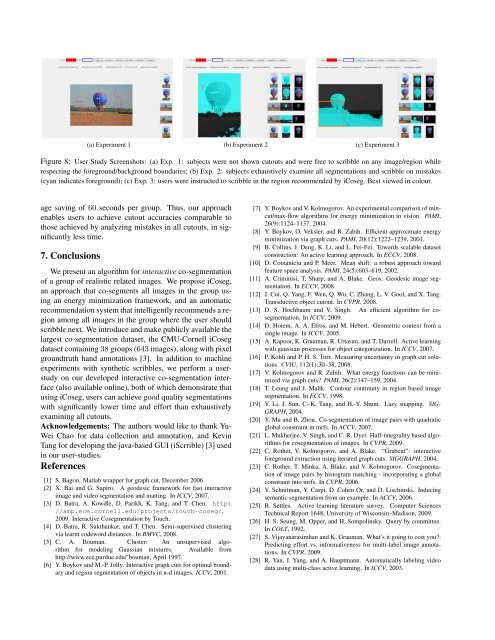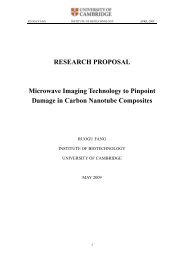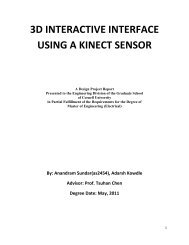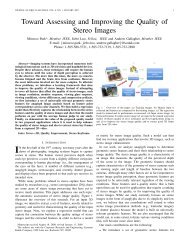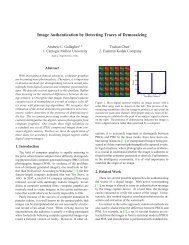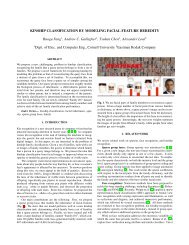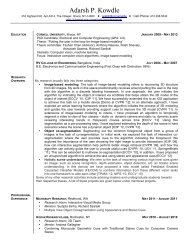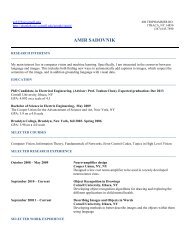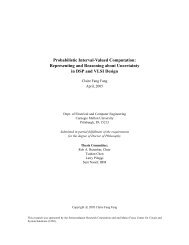iCoseg: Interactive Co-segmentation with Intelligent Scribble Guidance
iCoseg: Interactive Co-segmentation with Intelligent Scribble Guidance
iCoseg: Interactive Co-segmentation with Intelligent Scribble Guidance
You also want an ePaper? Increase the reach of your titles
YUMPU automatically turns print PDFs into web optimized ePapers that Google loves.
(a) Experiment 1 (b) Experiment 2 (c) Experiment 3<br />
Figure 8: User Study Screenshots: (a) Exp. 1: subjects were not shown cutouts and were free to scribble on any image/region while<br />
respecting the foreground/background boundaries; (b) Exp. 2: subjects exhaustively examine all <strong>segmentation</strong>s and scribble on mistakes<br />
(cyan indicates foreground); (c) Exp. 3: users were instructed to scribble in the region recommended by <strong>i<strong>Co</strong>seg</strong>. Best viewed in colour.<br />
age saving of 60 seconds per group. Thus, our approach<br />
enables users to achieve cutout accuracies comparable to<br />
those achieved by analyzing mistakes in all cutouts, in significantly<br />
less time.<br />
7. <strong>Co</strong>nclusions<br />
We present an algorithm for interactive co-<strong>segmentation</strong><br />
of a group of realistic related images. We propose <strong>i<strong>Co</strong>seg</strong>,<br />
an approach that co-segments all images in the group using<br />
an energy minimization framework, and an automatic<br />
recommendation system that intelligently recommends a region<br />
among all images in the group where the user should<br />
scribble next. We introduce and make publicly available the<br />
largest co-<strong>segmentation</strong> dataset, the CMU-<strong>Co</strong>rnell <strong>i<strong>Co</strong>seg</strong><br />
dataset containing 38 groups (643 images), along <strong>with</strong> pixel<br />
groundtruth hand annotations [3]. In addition to machine<br />
experiments <strong>with</strong> synthetic scribbles, we perform a userstudy<br />
on our developed interactive co-<strong>segmentation</strong> interface<br />
(also available online), both of which demonstrate that<br />
using <strong>i<strong>Co</strong>seg</strong>, users can achieve good quality <strong>segmentation</strong>s<br />
<strong>with</strong> significantly lower time and effort than exhaustively<br />
examining all cutouts.<br />
Acknowledgements: The authors would like to thank Yu-<br />
Wei Chao for data collection and annotation, and Kevin<br />
Tang for developing the java-based GUI (iScrrible) [3] used<br />
in our user-studies.<br />
References<br />
[1] S. Bagon. Matlab wrapper for graph cut, December 2006.<br />
[2] X. Bai and G. Sapiro. A geodesic framework for fast interactive<br />
image and video <strong>segmentation</strong> and matting. In ICCV, 2007.<br />
[3] D. Batra, A. Kowdle, D. Parikh, K. Tang, and T. Chen. http:<br />
//amp.ece.cornell.edu/projects/touch-coseg/,<br />
2009. <strong>Interactive</strong> <strong>Co</strong><strong>segmentation</strong> by Touch.<br />
[4] D. Batra, R. Sukthankar, and T. Chen. Semi-supervised clustering<br />
via learnt codeword distances. In BMVC, 2008.<br />
[5] C. A. Bouman. Cluster: An unsupervised algorithm<br />
for modeling Gaussian mixtures. Available from<br />
http://www.ece.purdue.edu/˜bouman, April 1997.<br />
[6] Y. Boykov and M.-P. Jolly. <strong>Interactive</strong> graph cuts for optimal boundary<br />
and region <strong>segmentation</strong> of objects in n-d images. ICCV, 2001.<br />
[7] Y. Boykov and V. Kolmogorov. An experimental comparison of mincut/max-flow<br />
algorithms for energy minimization in vision. PAMI,<br />
26(9):1124–1137, 2004.<br />
[8] Y. Boykov, O. Veksler, and R. Zabih. Efficient approximate energy<br />
minimization via graph cuts. PAMI, 20(12):1222–1239, 2001.<br />
[9] B. <strong>Co</strong>llins, J. Deng, K. Li, and L. Fei-Fei. Towards scalable dataset<br />
construction: An active learning approach. In ECCV, 2008.<br />
[10] D. <strong>Co</strong>maniciu and P. Meer. Mean shift: a robust approach toward<br />
feature space analysis. PAMI, 24(5):603–619, 2002.<br />
[11] A. Criminisi, T. Sharp, and A. Blake. Geos: Geodesic image <strong>segmentation</strong>.<br />
In ECCV, 2008.<br />
[12] J. Cui, Q. Yang, F. Wen, Q. Wu, C. Zhang, L. V. Gool, and X. Tang.<br />
Transductive object cutout. In CVPR, 2008.<br />
[13] D. S. Hochbaum and V. Singh. An efficient algorithm for co<strong>segmentation</strong>.<br />
In ICCV, 2009.<br />
[14] D. Hoiem, A. A. Efros, and M. Hebert. Geometric context from a<br />
single image. In ICCV, 2005.<br />
[15] A. Kapoor, K. Grauman, R. Urtasun, and T. Darrell. Active learning<br />
<strong>with</strong> gaussian processes for object categorization. In ICCV, 2007.<br />
[16] P. Kohli and P. H. S. Torr. Measuring uncertainty in graph cut solutions.<br />
CVIU, 112(1):30–38, 2008.<br />
[17] V. Kolmogorov and R. Zabih. What energy functions can be minimized<br />
via graph cuts? PAMI, 26(2):147–159, 2004.<br />
[18] T. Leung and J. Malik. <strong>Co</strong>ntour continuity in region based image<br />
<strong>segmentation</strong>. In ECCV, 1998.<br />
[19] Y. Li, J. Sun, C.-K. Tang, and H.-Y. Shum. Lazy snapping. SIG-<br />
GRAPH, 2004.<br />
[20] Y. Mu and B. Zhou. <strong>Co</strong>-<strong>segmentation</strong> of image pairs <strong>with</strong> quadratic<br />
global constraint in mrfs. In ACCV, 2007.<br />
[21] L. Mukherjee, V. Singh, and C. R. Dyer. Half-integrality based algorithms<br />
for co<strong>segmentation</strong> of images. In CVPR, 2009.<br />
[22] C. Rother, V. Kolmogorov, and A. Blake. “Grabcut”: interactive<br />
foreground extraction using iterated graph cuts. SIGGRAPH, 2004.<br />
[23] C. Rother, T. Minka, A. Blake, and V. Kolmogorov. <strong>Co</strong><strong>segmentation</strong><br />
of image pairs by histogram matching - incorporating a global<br />
constraint into mrfs. In CVPR, 2006.<br />
[24] Y. Schnitman, Y. Caspi, D. <strong>Co</strong>hen Or, and D. Lischinski. Inducing<br />
semantic <strong>segmentation</strong> from an example. In ACCV, 2006.<br />
[25] B. Settles. Active learning literature survey. <strong>Co</strong>mputer Sciences<br />
Technical Report 1648, University of Wisconsin–Madison, 2009.<br />
[26] H. S. Seung, M. Opper, and H. Sompolinsky. Query by committee.<br />
In COLT, 1992.<br />
[27] S. Vijayanarasimhan and K. Grauman. What’s it going to cost you?:<br />
Predicting effort vs. informativeness for multi-label image annotations.<br />
In CVPR, 2009.<br />
[28] R. Yan, J. Yang, and A. Hauptmann. Automatically labeling video<br />
data using multi-class active learning. In ICCV, 2003.


